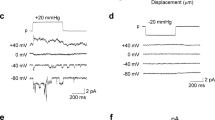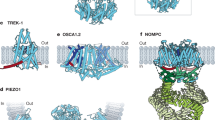Abstract
Transformation of mechanical energy into ionic currents is essential for touch, hearing and nociception. Although DEG/ENaC proteins are believed to form sensory mechanotransduction channels, the evidence for this role remains indirect. By recording from C. elegans touch receptor neurons in vivo, we found that external force evokes rapidly activating mechanoreceptor currents (MRCs) carried mostly by Na+ and blocked by amiloride—characteristics consistent with direct mechanical gating of a DEG/ENaC channel. Like mammalian Pacinian corpuscles, these neurons depolarized with both positive and negative changes in external force but not with sustained force. Null mutations in the DEG/ENaC gene mec-4 and in the accessory ion channel subunit genes mec-2 and mec-6 eliminated MRCs. In contrast, the genetic elimination of touch neuron–specific microtubules reduced, but did not abolish, MRCs. Our findings link the application of external force to the activation of a molecularly defined metazoan sensory transduction channel.
This is a preview of subscription content, access via your institution
Access options
Subscribe to this journal
Receive 12 print issues and online access
$209.00 per year
only $17.42 per issue
Buy this article
- Purchase on Springer Link
- Instant access to full article PDF
Prices may be subject to local taxes which are calculated during checkout






Similar content being viewed by others
References
Ernstrom, G.G. & Chalfie, M. Genetics of sensory mechanotransduction. Annu. Rev. Genet. 36, 411–453 (2002).
Goodman, M.B. et al. MEC-2 regulates C. elegans DEG/ENaC channels needed for mechanosensation. Nature 415, 1039–1042 (2002).
Chelur, D.S. et al. The mechanosensory protein MEC-6 is a subunit of the C. elegans touch-cell degenerin channel. Nature 420, 669–673 (2002).
Zhang, S. et al. MEC-2 is recruited to the putative mechanosensory complex in C. elegans touch receptor neurons through its stomatin-like domain. Curr. Biol. (in the press) (2004).
Suzuki, H. et al. in vivo imaging of C. elegans mechanosensory neurons demonstrates a specific role for the MEC-4 channel in the process of gentle touch sensation. Neuron 39, 1005–1017 (2003).
Goodman, M.B., Hall, D.H., Avery, L. & Lockery, S.R. Active currents regulate sensitivity and dynamic range in C. elegans neurons. Neuron 20, 763–772 (1998).
Alvarez-Buylla, R. & De Arellano, J.R. Local responses in Pacinian corpuscles. Am. J. Physiol. 172, 237–250 (1953).
Gray, J. & Sato, M. Properties of the receptor potential in Pacinian corpuscles. J. Physiol. (Lond.) 122, 610–636 (1953).
Chalfie, M. et al. The neural circuit for touch sensitivity in Caenorhabditis elegans. J. Neurosci. 5, 956–964 (1985).
Johnston, D. & Wu, S. Foundations of Cellular Neurophysiology (MIT Press, Cambridge, Massachusetts, USA, 1995).
Rankin, C.H. & Wicks, S.R. Mutations of the Caenorhabditis elegans brain-specific inorganic phosphate transporter eat-4 affect habituation of the tap-withdrawal response without affecting the response itself. J. Neurosci. 20, 4337–4344 (2000).
Wicks, S.R. & Rankin, C.H. Integration of mechanosensory stimuli in Caenorhabditis elegans. J. Neurosci. 15, 2434–2444 (1995).
Heinemann, S.H. & Conti, F. Nonstationary noise analysis and application to patch clamp recordings. Meth. Enzymol. 207, 131–148 (1992).
Kellenberger, S. & Schild, L. Epithelial sodium channel/degenerin family of ion channels: a variety of functions for a shared structure. Physiol. Rev. 82, 735–767 (2002).
Huang, M., Gu, G., Ferguson, E.L. & Chalfie, M. A stomatin-like protein necessary for mechanosensation in C. elegans. Nature 378, 292–295 (1995).
Hong, K., Mano, I. & Driscoll, M. in vivo structure-function analyses of Caenorhabditis elegans MEC-4, a candidate mechanosensory ion channel subunit. J. Neurosci. 20, 2575–2588 (2000).
Chalfie, M. & Au, M. Genetic control of differentiation of the Caenorhabditis elegans touch receptor neurons. Science 243, 1027–1033 (1989).
Huang, M. & Chalfie, M. Gene interactions affecting mechanosensory transduction in Caenorhabditis elegans. Nature 367, 467–469 (1994).
Savage, C. et al. mec-7 is a β-tubulin gene required for the production of 15-protofilament microtubules in Caenorhabditis elegans. Genes Dev. 3, 870–881 (1989).
Chalfie, M. & Thomson, J.N. Structural and functional diversity in the neuronal microtubules of Caenorhabditis elegans. J. Cell Biol. 93, 15–23 (1982).
Chalfie, M. & Sulston, J. Developmental genetics of the mechanosensory neurons of Caenorhabditis elegans. Dev. Biol. 82, 358–370 (1981).
Corey, D.P. & Hudspeth, A.J. Response latency of vertebrate hair cells. Biophys. J. 26, 499–506 (1979).
Walker, R.G., Willingham, A.T. & Zuker, C.S. A Drosophila mechanosensory transduction channel. Science 287, 2229–2234 (2000).
Hardie, R.C. Phototransduction in Drosophila melanogaster. J. Exp. Biol. 204, 3403–3409 (2001).
Tavernarakis, N., Shreffler, W., Wang, S. & Driscoll, M. unc-8, a DEG/ENaC family member, encodes a subunit of a candidate mechanically gated channel that modulates C. elegans locomotion. Neuron 18, 107–119 (1997).
Ainsley, J.A. et al. Enhanced locomotion caused by loss of the Drosophila DEG/ENaC protein Pickpocket1. Curr. Biol. 13, 1557–1563 (2003).
Price, M.P. et al. The mammalian sodium channel BNC1 is required for normal touch sensation. Nature 407, 1007–1011 (2000).
Price, M.P. et al. The DRASIC cation channel contributes to the detection of cutaneous touch and acid stimuli in mice. Neuron 32, 1071–1083 (2001).
Garcia-Anoveros, J., Samad, T.A., Woolf, C.J. & Corey, D.P. Transport and localization of the DEG/ENaC ion channel BNaC1α to peripheral mechanosensory terminals of dorsal root ganglia neurons. J. Neurosci. 21, 2678–2686 (2001).
Roza, C. et al. Knockout of the ASIC2 channel does not impair cutaneous mechanosensation, visceral mechanonociception and hearing. J. Physiol. 558, 659–669 (2004).
Hoger, U., Torkkeli, P.H., Seyfarth, E.A. & French, A.S. Ionic selectivity of mechanically activated channels in spider mechanoreceptor neurons. J. Neurophysiol. 78, 2079–2085 (1997).
Juusola, M., Seyfarth, E.A. & French, A.S. Sodium-dependent receptor current in a new mechanoreceptor preparation. J. Neurophysiol. 72, 3026–3028 (1994).
Diamond, J., Gray, J.A.B. & Inman, D.R. The relation between receptor potentials and the concentration of sodium ions. J. Physiol. (Lond.) 142, 382–394 (1958).
Ottoson, D. The effect of sodium deficiency on the response of the isolated muscle spindle. J. Physiol. (Lond.) 171, 109–118 (1964).
Drummond, H.A., Abboud, F.M. & Welsh, M.J. Localization of β and γ subunits of ENaC in sensory nerve endings in the rat foot pad. Brain Res. 884, 1–12 (2000).
Mello, C. & Fire, A. DNA transformation. Methods Cell Biol. 48, 451–482 (1995).
Zhang, Y. et al. Identification of genes expressed in C. elegans touch receptor neurons. Nature 418, 331–335 (2002).
Savage, C. et al. Mutations in the Caenorhabditis elegans β-tubulin gene mec-7: effects on microtubule assembly and stability and on tubulin autoregulation. J. Cell Sci. 107, 2165–2175 (1994).
Goodman, M.B. & Lockery, S.R. Pressure polishing: a method for re-shaping patch pipettes during fire polishing. J. Neurosci. Methods 100, 13–15 (2000).
Plasterk, R.H. Reverse genetics: from sequence to mutant worm. in Caenorhabditis elegans: Modern Biological Analysis of an Organism (eds. Epstein, H.F. & Shakes, D.C.) 59–78 (Academic Press, San Diego, USA, 1995).
Acknowledgements
We thank J. Cueva for electron microscopy and stereology measurements; A. Meshel for help devising the calibration method for stimulus probes; A. Kovach and S. Lockery for assistance; and R. Aldrich and D. Lenzi for comments on the manuscript. This research funded by a Howard Hughes Medical Institute predoctoral fellowship to R.O., National Institutes of Health grant GM20997 to M.C., and faculty fellowships from the Donald B. and Delia E. Baxter and Alfred P. Sloan Foundations to M.B.G.
Author information
Authors and Affiliations
Corresponding authors
Ethics declarations
Competing interests
The authors declare no competing financial interests.
Supplementary information
Supplementary Fig. 1
Behavioral touch sensitivity in wild type and mec-4 animals. Both e1339 and u316 show greater touch response rates for stimuli delivered to the tail than for those delivered to the head; the reason for this difference in sensitivity is unknown. Wild type and the null allele mec-4(u253) are shown for comparison. Between 25 and 61 animals were tested for each genotype. (PDF 99 kb)
Rights and permissions
About this article
Cite this article
O'Hagan, R., Chalfie, M. & Goodman, M. The MEC-4 DEG/ENaC channel of Caenorhabditis elegans touch receptor neurons transduces mechanical signals. Nat Neurosci 8, 43–50 (2005). https://doi.org/10.1038/nn1362
Received:
Accepted:
Published:
Issue Date:
DOI: https://doi.org/10.1038/nn1362
This article is cited by
-
Functional analysis in a model sea anemone reveals phylogenetic complexity and a role in cnidocyte discharge of DEG/ENaC ion channels
Communications Biology (2023)
-
Function and phylogeny support the independent evolution of an ASIC-like Deg/ENaC channel in the Placozoa
Communications Biology (2023)
-
A general pattern of non-spiking neuron dynamics under the effect of potassium and calcium channel modifications
Journal of Computational Neuroscience (2023)
-
C. elegans enteric motor neurons fire synchronized action potentials underlying the defecation motor program
Nature Communications (2022)
-
An economical and highly adaptable optogenetics system for individual and population-level manipulation of Caenorhabditis elegans
BMC Biology (2021)



